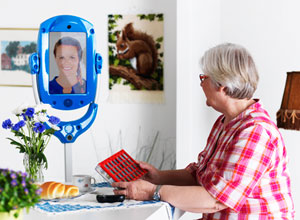Featured Article
Main Category: Alzheimer’s / Dementia
Also Included In: Caregivers / Homecare
Article Date: 09 Jul 2013 – 5:00 PDT
| Patient / Public: |  |
|
| Healthcare Prof: |  |
Caring for a person with dementia can be a full-time job. Characterized by memory loss, moodiness or communicative difficulties, the condition makes independent living quite difficult.
But now the carers or relatives of people living in remote areas with dementia may one day use a robot to check in on the patients.
The Giraff, which stands just over 3 feet tall, is a motorized robot that can facilitate a two-way video call. It can be controlled remotely with an ordinary computer and allows carers or relatives to interact with the patient from a different location.
The robot is being piloted in remote Scottish islands as part of the European Union project called “RemoDem,” which develops and tests various ways of helping people with dementia living in remote rural communities.
“For some with dementia, it can at times be a lonely life, particularly if their relatives are unable to visit them regularly,” says Gordon Jamieson, chief executive of NHS Western Isles.

The Giraff works in a similar way to Skype video chats, enabling communication between patient and carer.
The company developing the robot, also called Giraff, works with health organizations and research groups across Europe. The robot is being tested as a part of two different projects – “ExCITE” and “Giraff+” – to see how useful Giraff is for the elderly.
Chief executive of Giraff, Stephen Von Rump, first thought about how the technology might be used in the corporate world. It was not until several healthcare organizations contacted him that he realized the potential for the Giraff in helping the elderly stay connected with their environment while remaining independent.
Emelin Collier, head of planning for NHS Western Isles, sings the robot’s praises for people with dementia:
“The Giraff is simple to use; it is kept in the home of the person with dementia, and the controls for the robot are with the person’s relative or carer.
The relative could call into the robot to effectively waken it up, and the person with dementia would not have to do anything at all.
The caller’s face would appear on the screen, and the caller could then navigate the robot through the home of the person with dementia to check that all is well, check medication has been taken, food has been eaten, the person has washed and dressed or just to provide reassurance or have a chat.”
For patients who want to continue living independently with dementia, technology like the Giraff provides a necessary link to the outside world. And Jamieson adds that it doesn’t only apply to dementia: “As a new technology for us, the robot could also potentially be used in many other areas of healthcare to improve the quality of care, live access to specialists, and speed up consultations, regardless of location.”
A recent study showed that robot companions can improve quality of life for patients living with dementia.
Written by Marie Ellis
Copyright: Medical News Today
Not to be reproduced without permission of Medical News Today
Please use one of the following formats to cite this article in your essay, paper or report:
MLA
APA
Please note: If no author information is provided, the source is cited instead.
Add Your Opinion On This Article
‘Dementia Patients In Scotland Share Their Homes With Robots’
Please note that we publish your name, but we do not publish your email address. It is only used to let
you know when your message is published. We do not use it for any other purpose. Please see our privacy policy for more information.
If you write about specific medications or operations, please do not name health care professionals by name.
All opinions are moderated before being included (to stop spam)
Contact Our News Editors
For any corrections of factual information, or to contact the editors please use our feedback form.![]()
Please send any medical news or health news press releases to:
Note: Any medical information published on this website is not intended as a substitute for informed medical advice and you should not take any action before consulting with a health care
professional. For more information, please read our terms and conditions.

